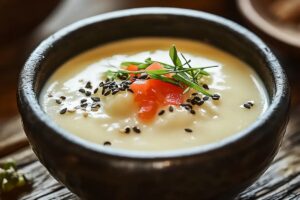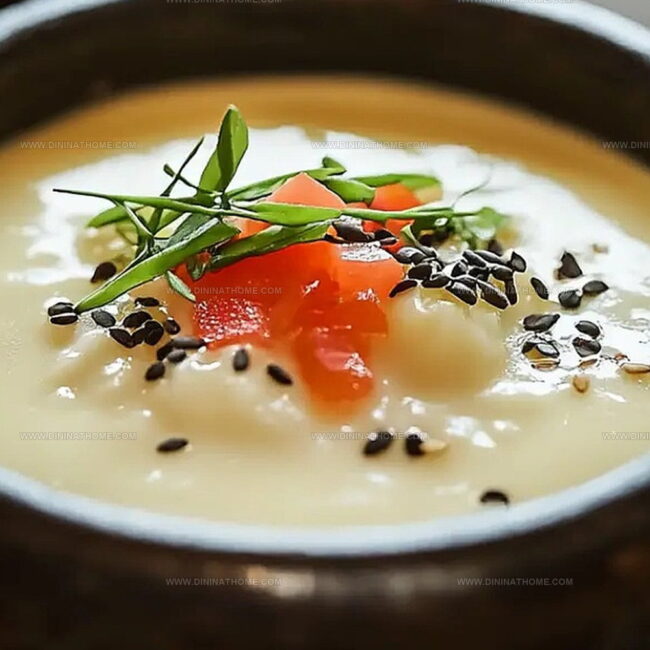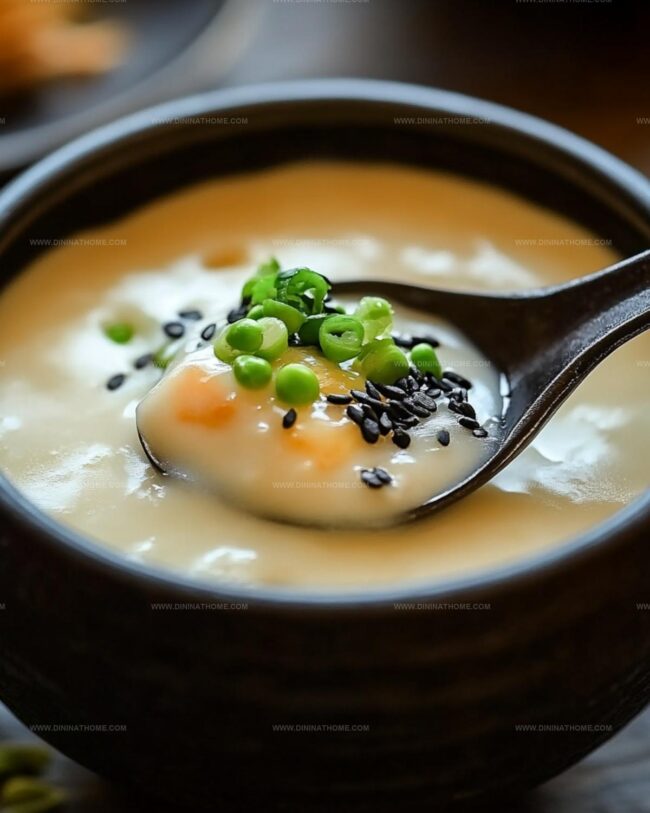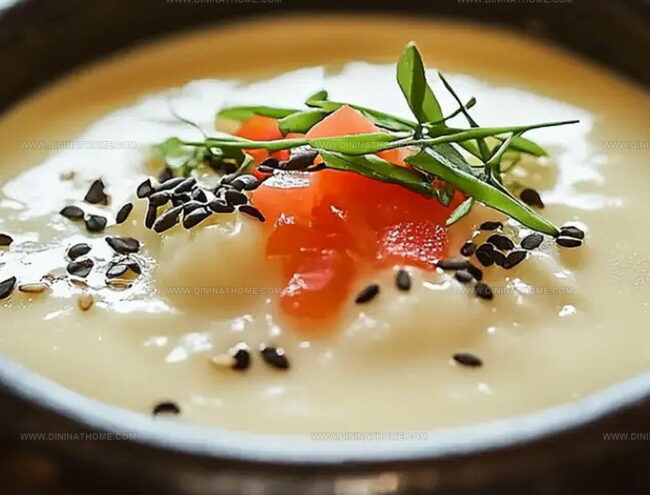Silky Chawanmushi: The Elegant Japanese Egg Custard Recipe
Japanese chawanmushi surprised me with its delicate silkiness during my first culinary adventure in tokyo.
Soft clouds of steamed egg dance beneath carefully arranged ingredients in a graceful ceramic cup.
Whisked eggs create a luxurious canvas for tender morsels of seafood and vegetables.
Subtle dashi broth infuses each spoonful with deep umami complexity that melts on your tongue.
Light yet satisfying, this elegant dish represents centuries of refined japanese cooking techniques.
Perfecting chawanmushi requires patience and a gentle touch that transforms simple ingredients into an extraordinary experience.
Dive into this recipe and unlock the secrets of a classic japanese comfort meal that will impress even the most discerning palates.
Steamed Egg Custard with Delicate Japanese Flair
Chawanmushi (Japanese Steamed Egg Custard) Ingredients
Main Ingredients:
Eggs: Creamy base for the delicate Japanese custard, fresh eggs provide the silky smooth texture.
Dashi: Traditional Japanese stock that brings deep umami flavor, essential for authentic taste.
Water: Helps create light and smooth custard consistency.
Seafood Ingredients:Seasoning Ingredients:Chawanmushi Steamed Egg Custard Prep Guide
Step 1: Whisk Eggs Smoothly
Gently beat eggs in a mixing bowl until the texture becomes completely uniform without creating excessive foam or bubbles.
Step 2: Create Flavor Base
Combine the following ingredients in a separate bowl:Stir everything thoroughly until all components blend seamlessly.
Step 3: Arrange Delicate Toppings
Select small heatproof cups or ceramic bowls and delicately place these ingredients inside:Distribute toppings evenly across each individual serving container.
Step 4: Transform Into Custard
Carefully strain the egg mixture through a fine mesh sieve into each prepared cup, ensuring you leave a small gap at the top for proper steaming.
Step 5: Steam To Perfection
Cover each cup with perforated plastic wrap to allow gentle steam circulation.
Place inside a steamer and cook over medium heat for approximately 15-20 minutes.
The custard is ready when it feels firm yet delicate when touched.
Step 6: Present With Elegance
Serve the chawanmushi immediately while warm, showcasing its luxurious and smooth texture as a delightful Japanese appetizer or side dish.
Custard Cooking Notes for Japanese Chawanmushi
Use a light hand when beating eggs to avoid creating air bubbles, which can make the custard less smooth and silky.
Adjust the dashi powder quantity to suit your taste preference, ensuring a rich umami flavor without overpowering the delicate egg custard.
Distribute seafood and mushrooms evenly at the bottom of the cups for a beautiful presentation and consistent flavor in each bite.
Check doneness by gently touching the surface – the custard should be firm yet jiggly, with no liquid egg remaining.
Let the chawanmushi rest for a couple of minutes after steaming to allow the custard to settle and achieve the ideal creamy consistency.
Store Chawanmushi (Japanese Steamed Egg Custard)
Sips That Suit Japanese Chawanmushi
Chawanmushi Texture and Garnish Options
FAQs
Dashi is a fundamental Japanese stock made from dried bonito flakes and kombu seaweed. It provides a rich, umami flavor that gives Chawanmushi its distinctive savory taste and depth.
Yes, you can customize the toppings. Use chicken, kamaboko (fish cake), edamame, or shiitake mushrooms as alternative protein and vegetable options that complement the delicate egg custard.
The custard should be smooth, silky, and wobble slightly when gently shaken. It should not have visible liquid egg and should feel soft and tender when touched with a spoon.
Chawanmushi is actually quite simple to prepare. The key is to whisk eggs gently, strain the mixture, and steam at a consistent medium heat to achieve the perfect smooth texture.
Print
Chawanmushi (Japanese Steamed Egg Custard) Recipe
- Total Time: 30 minutes
- Yield: 2 1x
Description
Chawanmushi brings silky Japanese elegance to delicate steamed egg custard, promising a luxurious culinary journey through subtle umami flavors. Smooth as silk and rich with dashi, seafood, and tender ingredients, this classic dish offers comfort and sophistication in each carefully crafted spoonful.
Ingredients
Main Protein:
- 3 eggs
- Mushrooms
- Shrimp
- Crab sticks
Liquid Base:
- 350 milliliters (11.8 fluid ounces) water
- 1 teaspoon soy sauce
Seasoning:
- 1/2 teaspoon dashi powder
- 1/2 teaspoon salt
- 1 teaspoon sugar
Instructions
- Gently whisk eggs in a mixing bowl, creating a silky, uniform consistency without excessive foam or bubbles.
- In a separate container, thoroughly blend water, dashi powder, salt, soy sauce, and sugar until ingredients are fully integrated and harmonious.
- Distribute chopped mushrooms, delicate shrimp, and sliced crab sticks evenly across individual heatproof ceramic vessels.
- Carefully pour the egg mixture through a fine-mesh strainer into each prepared cup, ensuring an even distribution while leaving a small margin at the top to prevent overflow during steaming.
- Securely cover each cup with perforated plastic wrap to allow gentle steam circulation and prevent water condensation from dripping onto the custard surface.
- Position cups in a steamer basket over simmering water, maintaining medium heat and cooking for approximately 15-20 minutes until the custard achieves a soft, trembling texture that springs back when lightly touched.
- Remove custards from steamer, allowing them to rest momentarily to stabilize their delicate structure.
- Present the chawanmushi immediately while warm, garnishing with a light sprinkle of finely chopped green onions or a subtle drizzle of soy sauce for enhanced flavor complexity.
Notes
- Gentle whisking prevents air bubbles, creating a silky smooth custard texture that melts in your mouth.
- Straining the egg mixture ensures an ultra-smooth consistency and removes any potential egg lumps for a professional finish.
- Adjust seasoning levels by reducing salt or using low-sodium dashi for those watching sodium intake or preferring milder flavors.
- Customize toppings with seasonal vegetables, different proteins like chicken or tofu, making this dish versatile for various dietary preferences and ingredient availability.
- Prep Time: 10 minutes
- Cook Time: 20 minutes
- Category: Lunch, Dinner, Appetizer
- Method: Steaming
- Cuisine: Japanese
Nutrition
- Serving Size: 2
- Calories: 119
- Sugar: 1 g
- Sodium: 400 mg
- Fat: 7 g
- Saturated Fat: 2 g
- Unsaturated Fat: 4 g
- Trans Fat: 0 g
- Carbohydrates: 6 g
- Fiber: 0 g
- Protein: 10 g
- Cholesterol: 186 mg





James Walker
Lead Recipe Developer & Culinary Educator
Expertise
Southern Cuisine & Farm-to-Table Cooking, Recipe Development & Testing, Culinary Education & Instruction
Education
School: Auguste Escoffier School of Culinary Arts
Program: Diploma in Culinary Arts and Operations
Focus: Comprehensive training in classical and modern culinary techniques, kitchen operations, and farm-to-table practices.
James didn’t learn cooking from a TV show, he learned it from busy kitchens, family gatherings, and long afternoons spent testing recipes the hard way.
After training at the Auguste Escoffier School of Culinary Arts, he brought his love for real, down-to-earth food to every dish he makes.
At Dining At Home, James loves building recipes that feel familiar but still have something special, like adding a twist to a classic or making a slow Sunday dinner feel brand new.
When he’s not in the kitchen, you’ll probably find him swapping garden tips at the farmers’ market or teaching his daughter how to flip pancakes without a mess (almost).